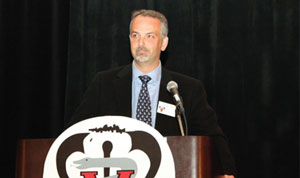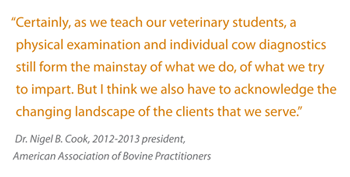Adapting services for bigger clients

Fewer companies own more cattle, and large cattle companies are more likely to hire and train nonveterinarians to perform care previously provided by veterinarians.
“We’re transitioning from being the person directly involved in the administration of care to our patients to a person who is a member of a team approach, hopefully involved in the training and monitoring and delivery of that care by others,” Dr. Nigel B. Cook said.
Yet, individual animal medicine and surgery will remain part of veterinarians’ roles on farms, Dr. Cook said.
“Certainly, as we teach our veterinary students, a physical examination and individual cow diagnostics still form the mainstay of what we do, of what we try to impart,” he said. “But I think we also have to acknowledge the changing landscape of the clients that we serve.”
Dr. Cook, 2012-2013 president of the American Association of Bovine Practitioners, was among the presenters at the AABP’s annual conference Sept. 19-21 in Milwaukee who described a need to adapt veterinary medicine to a changing livestock industry. Dr. Daniel L. Grooms became AABP president Sept. 21 (see article).
About 1,400 veterinarians and veterinary students, including veterinarians from 16 countries, attended the conference.
Dr. Cook said continuing to provide veterinary care to cattle may require a mix of convincing farms to pay for knowledge, rather than services, and continuing to treat individual sick cows. Rather than fighting the “parade of consultants” peddling services or advice to farms, he recommended helping farms by being a filter for good advice and how to implement it.
Various veterinary practice models will work with various farms, he said.
Fulfilling wants, expectations
Dr. Leon D. Weaver, who owns dairy cattle in Montpelier, Ohio, said cattle owners often are reluctant to work closely with herd veterinarians, because they see them as a compliance and cost issue rather than as a means to profit. He said those owners need to endorse any proposed changes, or else those changes will not succeed.
“They chair the committee,” he said. “You won’t go any further than they’ll let you.”
 Nonveterinarians can perform tasks such as dehorning and pregnancy checks for cows on the farm, he said, while veterinarians should train the people performing those procedures, measure farm performance, and act in a manner similar to a hospital chief of staff.
Nonveterinarians can perform tasks such as dehorning and pregnancy checks for cows on the farm, he said, while veterinarians should train the people performing those procedures, measure farm performance, and act in a manner similar to a hospital chief of staff.
Dr. John R. Wenz, an associate professor in the Washington State University College of Veterinary Medicine, said some clients can be convinced to think of veterinarians not as troubleshooters to call when problems occur but as consultants who know how to manage health and who should be paid for their intellectual contributions, even when cattle remain healthy. In that role, veterinarians can analyze data, learn what tasks are being performed by employees, and determine whether those employees are following farm protocols.
“The services tied to death and destruction are not sustainable,” he said.
Although lecturers at this and previous AABP annual meetings have described the benefits of working as farm consultants, a 2012 survey of AABP members indicates only one in 10 expect their practice will be performing much more consulting 15 years from now.
Dr. David Welch presented results from the AABP 2012 Economic Survey, which was conducted in August and September 2012 and based on 2011 financial information. About 280 of 370 respondents answered survey question about how they expect their practices will change during the next 15 years.
About one-sixth of those respondents expect their practice will not even exist. About a third expect their practice will grow during that time, and another third expect their practice will see fewer cattle. But most of those who expect to see fewer cattle also expect increased companion animal visits.
Fewer than one in 25 expects to see no change in the number of cattle under their care but also an increase in companion animals.
Educating clients and the public
Bruce G. Feinberg, a senior director of global restaurant quality for McDonald’s Corp. and leader of the company’s global animal health and welfare team, said customers are demanding greater transparency in producing food. He expects veterinarians will increasingly have roles coaching, teaching, and creating awareness among clients to help them meet expectations.

Feinberg said public perception of food science has become increasingly negative. New technologies are seen primarily as beneficial for agriculture companies and may not be viewed as safe.
For example, he said that, when companies say they need to use a particular technology to increase production and feed the world, consumers instead assume the motivation is to sell more food. Consumers also want more social responsibility from global companies, and he expects that future generations will have even less trust in company practices and will demand more transparency.
Feinberg said in an interview after the AABP meeting that academics have told him they are adapting the veterinary medical curriculum to help students better understand their future roles beyond diagnosis and treatment.
“At the educational institution level, the challenge is that veterinary schools are going to have to modify the curriculum in order to stay current with what the consumers of tomorrow want,” he said.
Dr. Cook said in his presentation that his university has revamped its core skill set taught in dairy medicine, ensuring veterinary students can serve farms with large herds. Veterinarians working for such clients will need to understand and interpret records, use herd management software, analyze data trends, troubleshoot morbidity and mortality problems, and, yet, still work with individual cows.
He also encouraged veterinarians attending the AABP meeting to consider how they market their services. The clothes a veterinarian wears when proposing a change, providing a written report and cost estimate, giving contact information for a person who can accomplish the task, and taking into account the farmer’s motivation for the change are among such considerations.
Listen well and deliver information in the right way, he said.